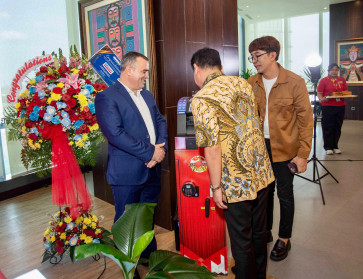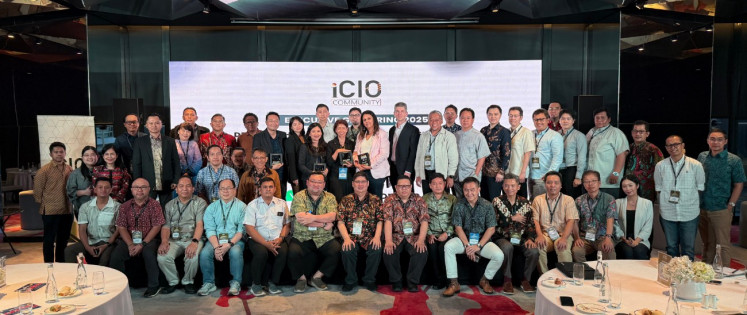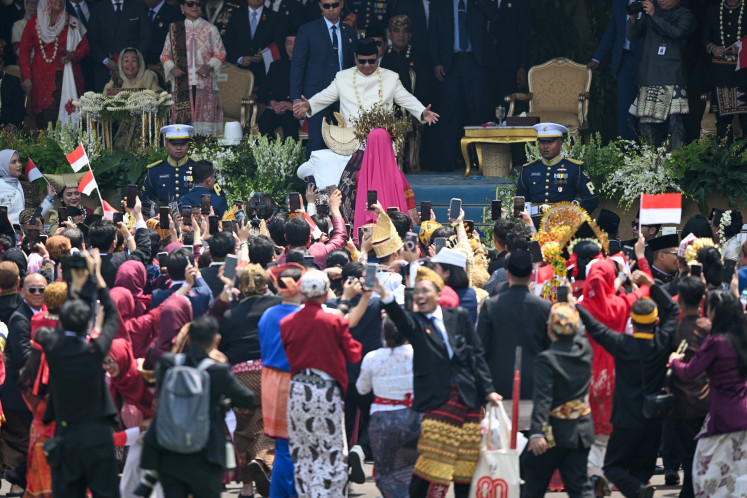Popular Reads
Top Results
Can't find what you're looking for?
View all search resultsPopular Reads
Top Results
Can't find what you're looking for?
View all search resultsLaunch of film series, ‘Nyantrik’ empowers youth via Wayang Theater on Indosiana.TV
Change text size
Gift Premium Articles
to Anyone
T
he Directorate General of Culture of the Education, Culture, Research, and Technology Ministry launched the film series Nyantrik on Monday.
The event, held at the Ki Narto Sabdo Cultural Building in Semarang City, was attended by Central Java Governor Ganjar Pranowo, Semarang Mayor Hevearita Gunaryanti Rahayu, the Director General of Culture of the Education, Culture, Research, and Technology Ministry Hilmar Farid and the Director of Film, Music, and Media of the Directorate General of Culture, Ahmad Mahendra.
The screening of the film, Nyantrik, serves as a bridge for the younger generation to immerse themselves in learning Wayang Orang, traditional Javanese theater. The series will be aired on the local channel, Indosiana.TV, where the performance of Nyantrik begins with the episode of Dewabrata, or Bisma, driving away the goddess Amba.
Hilmar said Nyantrik is part of the Indonesiana.TV socialization activities that carry the theme of Culture, Inspiration and Exploration. This is a series that depicts the learning process of nine Indonesian actors and actresses in the four traditional Wayang Orang (WO) studios that are still active in Indonesia, namely: WO Bharata Jakarta, WO RRI Surakarta, WO Sriwedari Surakarta and WO Ngesti Pandowo Semarang.
With the theme“Ketika yang Muda Belajar dari Panggung Wayang Orang”, which translates to “When the young learn from the Wayang Orang stage,” Nyantrik is a collaborative program between the younger generation and the maestros of Wayang Orang. The word nyantrik itself derives from an ancient Javanese word that means to apprentice or learn.
“Throughout the production process of this miniseries, the core principles of nyantrik were emphasized,” explained Hilmar. “In line with the philosophy of nyantrik, the cantrik [students] were trained not only to observe and imitate what is shown by their mentors, but to also deeply understand the essence of what they are learning.”
Hilmar added how the strategic Indonesiana.TV program, “is expected to play a significant role in the development and utilization of culture. As a media platform, Indonesiana.TV serves as a bridge between traditional art and the contemporary generation as well.”
Directed by Lasja F. Susatyo, Nyantrik features young actors and actresses such as Kelly Tandiono, Samo Rafael, Clara Bernadeth, Karina Salim, Ravil Prasetya, Omara Esteghlal, Tatyana Akman, Cindy Nirmala, and Daniel Adnan as the cantrik students.
The actors and actresses learned and delved into the art of performing Mahabharata scenes from maestros like Kenthus Ampiranto from WO Bharata Jakarta, Ali Marsudi from WO RRI Surakarta, Wasi Bantolo from ISI Surakarta, Agus Prasetyo from WO Sriwedari Surakarta and Nanang Hape as a puppeteer and scriptwriter.
History of Wayang Orang (WO)
The Nyantrik program synthesizes several stages of WO’s development. WO itself is believed to be a very ancient form of performing art. Some ancient inscriptions like Prasasti Mantayasih (904 AD) and Prasasti Wimalasmara (930 AD) have mentioned performances utilizing the terms, hatapukan or matapukan and awayang wang in Old Javanese.
The period of these inscriptions proves that this art has been in existence since the birth of ancient Mataram and was presented exclusively at the palace.
After that, WO was also performed in the newly emerging kingdoms in East Java, including Majapahit. Over time, WO was revived in the era of Mangkunegaran I (1760) and Hamengkubuwono I (1750s) within the context of state ritual performances in the palace or to celebrate important ceremonies.
However, the most significant change occurred in the late 19th century. The performing art stepped outside the palace walls and began to be presented as commercial performances.
Objectives of the ‘Nyantrik’ program
Times change, and so do cultural products. This challenges one to keep up with the expectations for new forms of aesthetic experiences. Traditional art is at risk when its existence does not experience development to a certain extent.
The miniseries Nyantrik is created as a response to the concern about the wide gap between classical traditional art and the younger generation. The creation of Nyantrik aims to convey the essence of tradition in today’s language.
Fragments from the epics of Mahabharata and Ramayana, rich with wise advice, are packaged in an attractive and entertaining manner with a blend of visual technology while still retaining the touch of classical art.











